Topics
Research Interests
Interacting fermions are at the core of the most studied, and yet poorly understood, properties of solids such as high temperature superconductivity, Mott-insulator, heavy fermions, and giant magnetoresistance. In addition to electron-electron interactions in many correlated electron systems the interactions with other degrees of freedom, such as Phonon, Magnons and Orbitons, is crucial to determine the electronic ground stated and therefore their physical properties.
A possible way for distinguishing the roles of the different degrees of freedom and their interactions is to study the dynamical evolution of materials following a controlled perturbation. This philosophy is beyond all the studies tackling the physics of complex systems by means of ultrafast time domain studies.
In addition to reveal the competing orders in quantum materials, the light-matter interaction can be used to control the emergence of new functional properties of matter.
In our lab, we follow a threefold approach:
- Cavity-control of material properties

In quantum mechanics, the presence of a cavity surrounding a certain dipole can be described as a coherent evolution in which a photon is repeatedly absorbed and reemitted by the dipole itself. In this limit, called strong light-matter coupling, the light-matter interaction overcomes the dissipative processes and the wavefunctions of the material excitations and the photon inside the cavity are coherently mixed, forming hybrid light-matter states called polaritons.
Exploring the strong limit of light-matter hybridization is recently emerging as a promising route to control collective macroscopic properties in complex materials.
We are pursuing this research line by implementing a unique experimental platform to hybridize low-energy excitations in quantum materials in cryogenic THz and sub-THz cavities and ultimately control the emergence of cooperative phenomena.
Relevant publications: Jarc et al. RevSciInstr (2022), Jarc et al. Nature (2023)
- Ultrafast manipulation of coherent phases by long-wavelength photoexcitation

The photoexcitation within time windows shorter than the characteristic times of the relaxation processes drives matter into highly off-equilibrium transient regimes characterized by anomalous energy distribution between electrons, ions, and spins. This can strongly perturb the interaction among the different degrees of freedom and thereby results in the formation of metastable “phases”, not always reachable under quasi-equilibrium adiabatic transformations.
While the most widely used approach consists in injecting high-energy photoexcitations (>1 eV), different excitation schemes based on low-energy (mid-IR and THz) pulses are emerging as a more attractive option, allowing for a resonant excitation of low-energy modes in solids such as vibrations and magnetic excitations. In fact, in contrast phase transitions driven by high-photon energy fields, phase transitions driven by the coherent control of low-lying excitation are directly due to the large-amplitude low-frequency excitation of the bosonic modes produced by the electromagnetic field and are not related to hot-carrier injection.
We have been developing a multi-pulse broadband spectroscopy based on the selective photoexcitation of both high- and low-energy degrees of freedom to determine the time-dependent evolution of the spectral weight of the different features characterizing the optical response of complex materials, such as high temperature superconductors and 2D materials.
Relevant publications: Giusti et al. PRL (2019), Montanaro et al. RevSciInstr (2020), Marciniak et al. NatPhysics (2021), Giusti et al. PRB (2021), Montanaro et al. NatComm (2022)
- Classical and quantum fluctuations to access the full photon number statitics
 Standard time domain experiments measure the time evolution of the reflected/transmitted mean number of photons in the probe pulses. The evolution of the response of a material is typically averaged over the illuminated area as well as over many pump and probe measurements repeated stroboscopically.
Standard time domain experiments measure the time evolution of the reflected/transmitted mean number of photons in the probe pulses. The evolution of the response of a material is typically averaged over the illuminated area as well as over many pump and probe measurements repeated stroboscopically.
However, by averaging over several light pulses, information on the higher-order momenta of the photon distribution is lost.
We have been implementing a new research framework to go beyond mean photon number observables and use instead photon number fluctuations to provide a richer statistical information. The ultimate goal is to understand if, and eventually how, the quantum properties of light are dynamically affected by the interaction with strongly correlated materials and therefore how the study of photon distribution can be used to address the intricate interplay of their degrees of freedom.
Relevant publications: Esposito et al. NatComm (2016), Randi et al. PRL (2017), Tollerud et al. PNAS (2019), Glerean et al. OptLett (2020), Sparapassi et al. Nature:LightSciAppl (2022)
